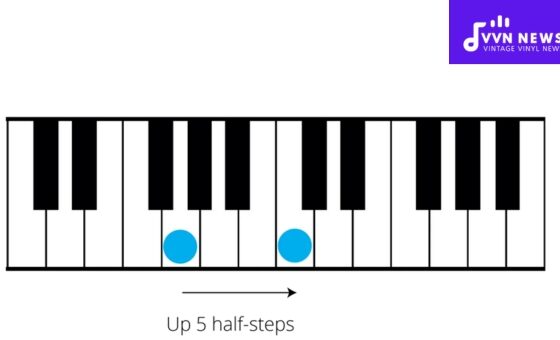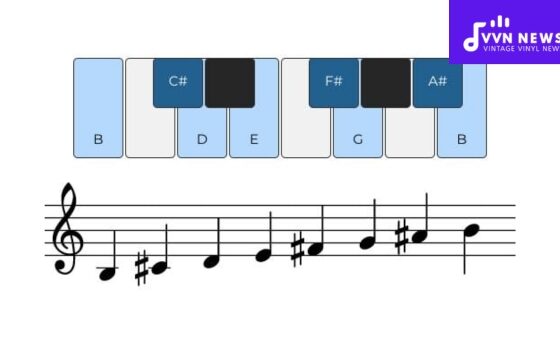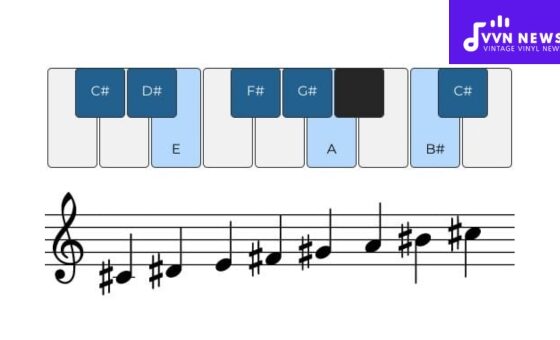Mastering musical scales can sometimes feel like deciphering a complex mathematical equation.
When it comes to the simplicity and beauty of sound, there’s one scale that stands out – the D flat major pentatonic scale.
While it’s true that music theory is a subject filled with intricacies, once you start breaking it down step by step, it becomes effortlessly accessible.
One such concept that’s both essential to grasp yet easily understandable is the scale we will discuss today – the D flat major pentatonic scale.
What Defines the D Flat Major Pentatonic Scale?
The D flat major pentatonic scale is characterized by its unique combination of notes and a signature tune that lends itself to many musical compositions across various genres.
The D flat major pentatonic scale contains five notes: D flat (Db), E flat (Eb), F, A flat (Ab), and B flat (Bb).
While the major and minor scales consist of seven notes, the simplicity and distinctive sound of the pentatonic scale sets it apart.
This scale has an unmistakably smooth flow, often used in pop, jazz, blues, and rock music to lend a velvety touch to melodies and compositions.
How is the D Flat Major Pentatonic Scale Constructed?
The crux of constructing a D Flat Major Pentatonic Scale lies in learning and following these sequential steps:
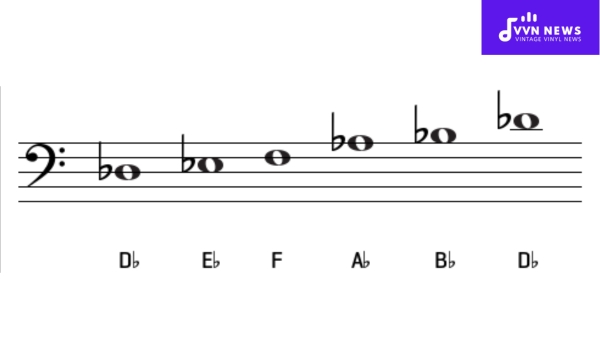
- Start with the Major Scale: The first step is to know your D Flat (or Db) major scale. In case you are unsure, a Db major scale consists of the notes: Db – Eb – F – Gb – Ab – Bb – C – Db.
- Select the Relevant Notes: Now that you’ve got your Db major scale, we need to pick out certain specific notes from this scale to form your pentatonic scale. Remember, ‘penta’ means five, so we’ll be choosing five specific notes.
- Rule for Selection: These notes would be the 1st, 2nd, 3rd, 5th, and 6th degrees of the major scale. Therefore, following this rule for the Db Major Scale will yield Db (1st), Eb (2nd), F (3rd), Ab (5th), and Bb (6th).
- Construct Your Sequence: Once you have selected these notes, string them together in ascending order to make your D Flat Major Pentatonic Scale: Db – Eb – F – Ab – Bb.
- Create Octaves: For broader versatility in playing music and practicing improvisation, extend this basic sequence across multiple octaves.
It’s fascinating how just a simple rearrangement of pre-existing musical building blocks can bring about this rather unique sonic the D Flat Major Pentatonic Scale.
What are the D Flat Major Pentatonic Scale five shapes?
Playing any scale is not just about memorizing particular notes. It’s also vital to learn the shapes that these scales form on the fretboard.
A deep working knowledge of these shapes will not only expand your freedom on the fretboard but it can also add more sophistication to your solos.
For the D flat major pentatonic scale, you’ll need to familiarize yourself with five main shapes.
Shape 1
The first shape starts from the root note D flat (Db). Begin your journey on the low E string, 9th fret (this is our Db).
Travel through this shape by playing consecutive notes 9-11 on E and A strings, followed by 8-11 on the next string.
Crossing over to G and B strings requires a bit of finger movement (9-13). Finally, conclude with going from fret 11 to 14 in high E string.
Shape 2
The second shape kicks off from Eb, which falls at the 11th fret of the lower E string.
The pattern goes like this: play on the 11th and then jump to the 14th fret of both lower E and A strings.
Subsequently, move on to nailing down notes between the 11th and 13th frets for three consecutive guitar strings (D, G & B), after which you wrap it up at the high E string by playing notes from 11 to 14.
Shape 3
For Shape three, we initiate from Fm that occurs at low-E’s 13th fret. Shift smoothly between frets 13-16 through two initial strings followed by moving on to grip notes placed right between15-16 between the D and G strings respectively.
You then proceed further to focus on the B string (14-17), closing things off finally in high E by slipping smoothly from 15 to 16 fret.
Shape 4
Shape four commences from the 15th fret. You are to engage actively on the lower E and A string from fret 15 to 18.
Shifting your attention promptly to D and G, slide between 16-18 frets, and finally finish off at the B and high E strings by playing notes between17-19.
Shape 5
Shape five is initiated on Ab (17th fret of low E string). Span across consecutive low strings by moving in between frets 17-20.
Follow this by targeting D & G strings that will require you to handle notes placed right within 18-21.
Swing then towards B (19-21), bringing everything neatly to a close at high E while slipping smoothly from to.
You may initially find these shapes challenging but with consistent practice, these patterns will become second nature.
So forge ahead with tenacity – excellent musicality awaits you at the destination.
Also Read: F Sharp Minor Scale [Discover Its Heartfelt Musical Qualities]
How do Major and Minor Pentatonic Scales relate?
The concept of relative major and minor scales is a significant one in music.
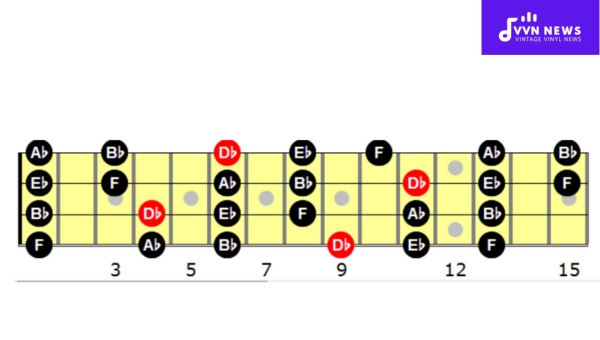
Essentially, this includes two scales – one major, one minor – sharing the same key signature.
The crucial point to remember here is that the minor scale begins on the 6th degree of the relative major scale.
For instance, consider the C Major Scale and its associated A Minor Scale.
These scales are considered ‘relatives’ as they both share the same notes – only their starting points differ.
In the context of D flat Major Pentatonic Scale, B flat minor Pentatonic is its relative minor scale.
By knowing this relationship, you have access to an expanded range of notes for your melodies and solos whilst maintaining harmonic consistency within your music.
This insight plays an integral part, especially for those venturing into improvisation.
It’s noteworthy that each scale brings its unique tonal quality despite their shared notes.
It’s fascinating how a simple shift in starting point can invoke contrasting moods – often described as happy for major scales and sad or introspective for minor ones.
How do backing tracks help practice the D Flat Major Pentatonic Scale?
The essence of jamming couldn’t be understated in the world of music. It gives you that unscripted, off-the-cuff freedom to create, improvise, and truly feel the music.
One of the most effective tools for this is using backing tracks – particularly when practicing and mastering scales like our focus today: the D flat major pentatonic scale.
Let’s dive deeper into how backing tracks contribute to your practice:
Foundation for Soloing
Utilizing backing tracks provides an excellent platform to showcase your soloing skills.
With a solid foundation in place, you are free to experiment with the D flat major pentatonic scale.
This encourages creativity as you navigate your way through the notes and tones.
Improves Timing
Playing along with a pre-recorded track significantly boosts your timing skills.
You learn to adapt, ensuring each note fits seamlessly within the tempo, ultimately sharpening your overall rhythm instincts.
Encourages Musical Versatility
It’s all well and good to master a scale in solitude. Yet playing it alongside other instruments on a backing track primes you for real-life band situations: decoding chord progressions, layering melodies, changing key mid-way – it all becomes second nature over time.
Allows Real-time Corrections
Backing tracks offer the invaluable benefit of real-time corrections.
You’re slightly off tempo or missing a note – mistakes become immediately apparent.
This accelerates your learning progress significantly as you can pinpoint and amend issues on the spot.
Utilizing backing tracks while practicing your D flat major pentatonic scale is a valuable resource to utilize.
It enables you to create a dynamic, immersive practice session – molding you into a versatile and confident musician.
Also Read: C Sharp Minor Scale [Master This Mood-Setting Musical Key]
Songs that Use the D Flat Major Pentatonic Scale
The beauty of the D Flat Major Pentatonic scale is that it can transform an ordinary song into a melodious work of art.
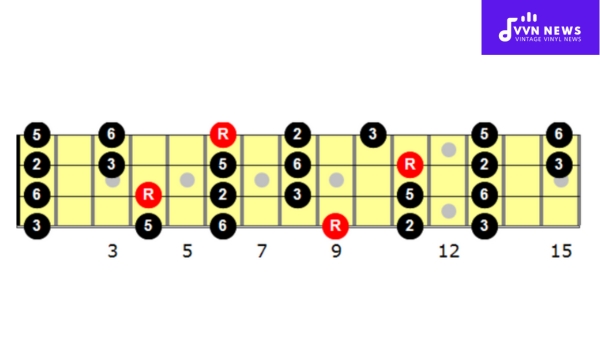
It’s a well-known fact that countless musical legends have used this scale to produce phenomenal tracks that have made history in their respective genres.
Here are five noteworthy tracks that feature this particular scale.
- “Imagine” by John Lennon: Lennon’s iconic track has moved millions with its heartfelt lyrics and beautiful melody. The song’s foundational melody revolves around the D Flat Major Pentatonic Scale, painting a soothing audio scape for listeners worldwide.
- “My Girl” by The Temptations: This evergreen classic showcases the soothing use of the D flat major pentatonic scale and continues to stand as a testament to Motown music’s brilliance. Its simple and elegant sound cements the beastly beauty of our chosen scale.
- “Mr. Brightside” by The Killers: This modern-rock anthem charms people with its infectious energy and catchy tune constructed around the DBMPS, aptly demonstrating the versatility of this impressive scale.
- “Just The Way You Are” by Bruno Mars: A shining example from pop-genre, Bruno Mars skilfully incorporates DBMPS blending it seamlessly with his powerful vocals creating an anthem for lovers around the world.
- “Clair de Lune” by Claude Debussy: From the classical genre, notable composer Debussy has demonstrated effective use of this melodious scale in parts of this renowned composition – interweaving harmony with emotion perfectly through his music.
All these songs exhibit how musicians across times leverage this versatile scale, highlighting its ability to create different music styles – from serene melodies to enthusiastic rhythms – while preserving its signature characteristics.
FAQs About The D Flat Major Pentatonic Scale
What exactly is a pentatonic scale?
A pentatonic scale is a musical scale with five notes per octave. It’s commonly used in many types of music across different cultures.
Why should I learn the D Flat Major Pentatonic Scale?
The D Flat Major Pentatonic Scale offers a pleasing sound that’s easy to implement in solos and melodies. Its simplicity makes it an excellent tool for improvisation in various music genres.
Can I play the D Flat Major Pentatonic on other instruments aside from the guitar?
Yes, absolutely! You can play the D flat Major Pentatonic Scale on any musical instrument, including piano, saxophone, flute, and many others.
How can I practice the D Flat Major Pentatonic scale?
Practice it by playing its five distinct shapes or patterns and also by using backing tracks, which can help embed the sounds and shapes of this scale into your muscle memory and ear training.
Where can I hear some examples of the D Flat Major Pentatonic Scale in use?
There are numerous jazz, pop, rhythm and blues, country, and rock songs that utilize this scale. Listening to these genres will offer you abundant examples.
Conclusion
In essence, the D Flat Major Pentatonic Scale is not just a tool for composing or improvising music, but also a path to knowing musical relationships and unlocking creativity.
It’s your stepping stone towards exploring more complex musical scales and concepts.
The journey of learning this scale is an exciting one, filled with discovery, self-expression, and even an improved ability to communicate musically.
Don’t forget to make use of online resources like backing tracks, tutorials, or online metronomes for practice.

